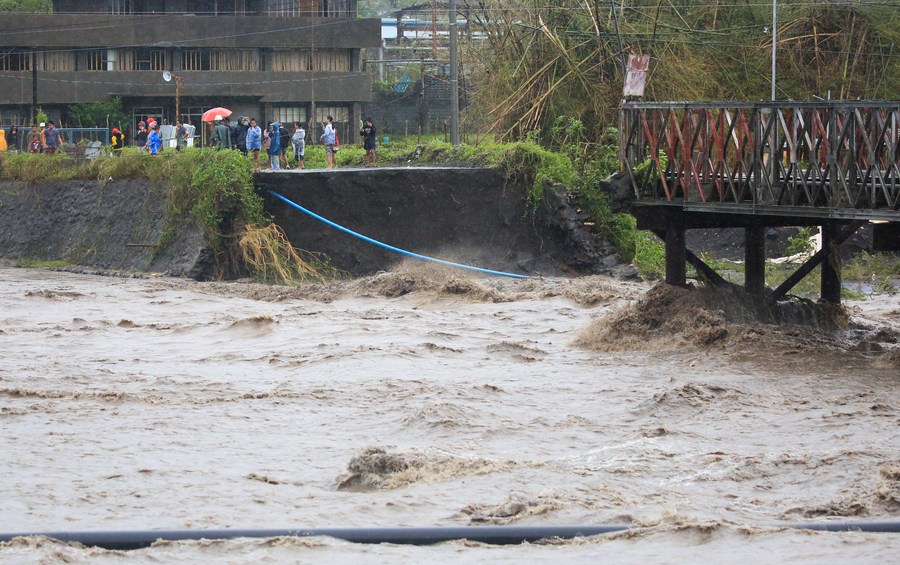
A bridge is damaged by the flood brought by the heavy rains from typhoon Goni in Albay Province, the Philippines on Nov. 1, 2020. (Xinhua/Stringer)
Between 19 million to 31 million people in the Philippine, about a quarter of the country's whole population, could be affected by Super Typhoon Goni, which made landfall in Catanduanes island province in the Bicol region before dawn on Sunday.
MANILA, Nov. 1 (Xinhua) -- Super Typhoon Goni barrelled into the southern part of the Philippines' main Luzon island with "catastrophic violent winds and intense torrential rains" on Sunday, triggering flash floods and mudslides that killed at least four people.
The typhoon, which made landfall in Catanduanes island province in the Bicol region before dawn on Sunday, has weakened, but it still left a trail of destruction in 12 out of the 17 regions in the Philippines.
The National Disaster Risk Reduction and Management Council (NDRRMC) has said that between 19 million to 31 million people in the Philippine, about a quarter of the country's whole population, could be affected by Super Typhoon Goni.
Albay province Governor Al Francis Bichara said his office has accounted four deaths so far - three, including a four-year-old child, died from swollen river, and one was pinned by a fallen tree. Fierce wind ripped off the roof of an evacuation center, he added.
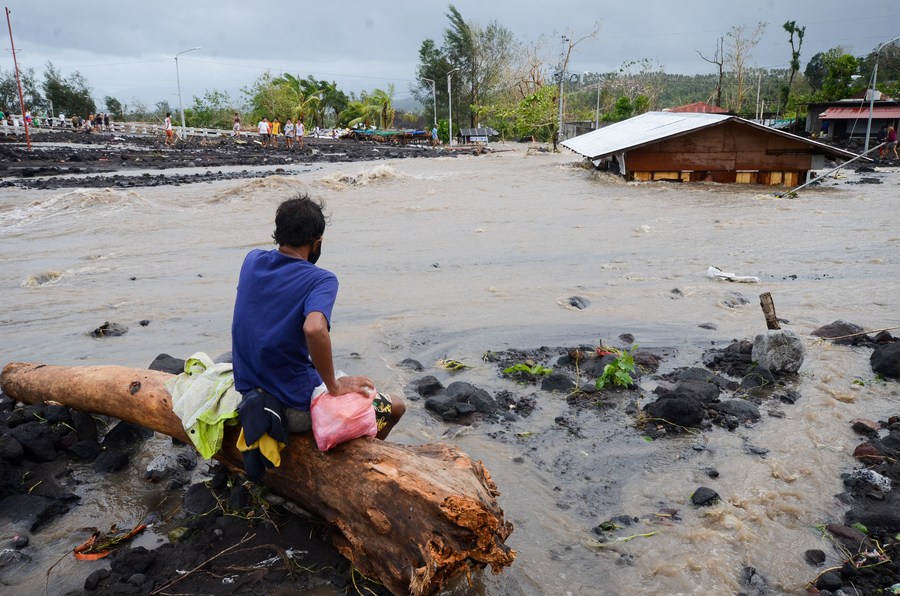
A man looks at a house submerged in floodwaters brought by the heavy rains from typhoon Goni in Albay Province, the Philippines on Nov. 1, 2020. (Xinhua/Stringer)
Initial media reports said the typhoon destroyed houses, toppled trees and power posts in Albay province.
A male resident of Guinobatan town said a river in his town overflowed and caused flooding in nearby areas, "At the height of flood, it was 16 feet deep. Other areas fared worse," he said.
"We have not gone out yet and we expect the damage is much worse," he added.
PAGASA, Philippine' weather bureau, said that "local flooding is occurring in low-lying areas, agricultural areas and urban areas with poor drainage system" in the provinces of Albay and Camarines Sur.
The typhoon also flooded the Cagsawa ruins national park, a favorite tourist destination in Daraga town in Albay province with the picture-perfect cone-shaped Mayon volcano in the background.
Undersecretary Ricardo Jalad, the executive director of NDRRMC, said in an online briefing that nearly 347,000 people in areas prone to flooding and landslide in Metro Manila, the Bicol region, Central Luzon, provinces south-east of Manila, and Eastern Visayas in the central Philippines were evacuated.
Goni intensified into a super typhoon almost three hours before hitting land in Bato town in Catanduanes province, an island province in the southeastern part of Luzon at around 4:50 a.m.
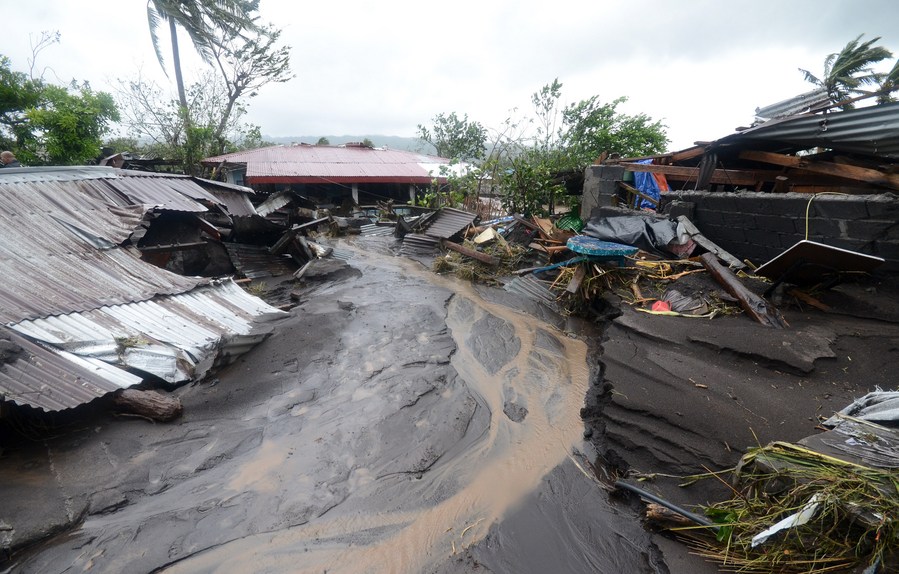
Houses are buried in lahar after a flood brought by the heavy rains from typhoon Goni in Albay Province, the Philippines on Nov. 1, 2020. (Xinhua/Stringer)
The bureau said Goni, blowing maximum sustained winds of 225 km per hour near the center and gustiness of up to 310 km per hour, made second landfall in Tiwi town in Albay province around 7:20 a.m. local time.
At 8 a.m., the bureau said Goni weakened into a typhoon as it blows towards the provinces of Marinduque and Quezon. Goni is forecast to weaken as it cuts through the provinces of Batangas and Cavite before heading to the South China Sea on Sunday night, the bureau added.
The Philippine Coast Guard ordered dozens of ports closed after the government imposed a "no sail policy," leaving travelers stranded.
Airport authorities also shut down Manila's international airport for 24 hours from 10 a.m. on Sunday.
In Manila, officials ordered big roadside advertising boards taken down, fearing strong winds could knock it down and injure people.
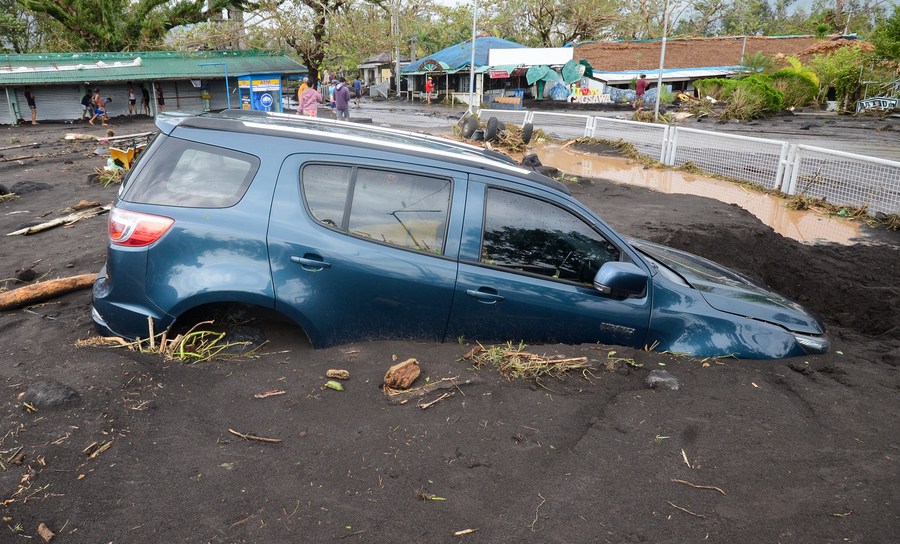
A car is seen buried in lahar after a flood brought by the heavy rains from typhoon Goni in Albay Province, the Philippines on Nov. 1, 2020. (Xinhua/Stringer)
Super Typhoon Goni, the 18th cyclone to hit the Philippines this year, struck close to the regions hit by Typhoon Molave early this week, which killed 22 people and destroyed infrastructure and crops.
Meanwhile, the state weather bureau said it is also tracking Tropical Depression Atsani churning in the Pacific Ocean 1,365 km east of southern Luzon.
The cyclones hit as the Philippines grapples with the COVID-19 pandemic. The Philippines now has 383,113 confirmed COVID-19 cases, including 348,760 recoveries and 7,238 deaths.
Health Secretary Francisco Duque said in an online briefing that COVID-19 patients and health workers in temporary treatment and monitoring facilities in Metro Manila were moved to hotel isolation facilities to ensure their safety. COVID-19 patients and staff in Albay province were transferred to day care centers, public schools, and evacuation centers, he added.
Duque urged the public to continue practicing minimum public health standards to prevent transmission of COVID-19 in their homes and in evacuation centers.
Typhoons and tropical storms regularly hit the Philippines from June through December, claiming hundreds of lives and cause billions of U.S. dollars in damages.
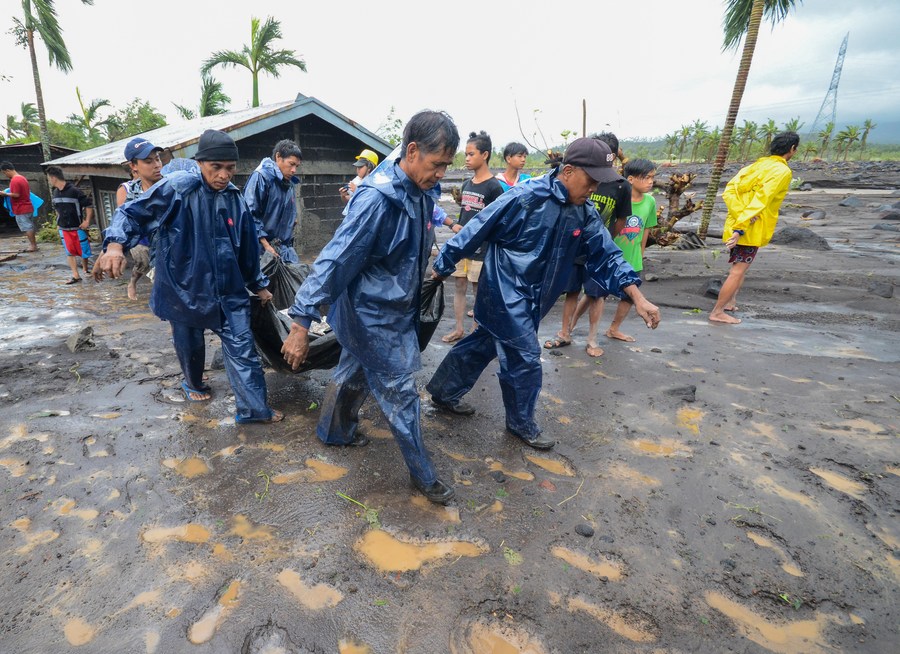
Emergency responders carry a dead person who was buried in lahar after a flood brought by the heavy rains from typhoon Goni in Albay Province, the Philippines on Nov. 1, 2020. (Xinhua/Stringer)
Typhoon Haiyan, one of the country's worst, killed over 7,000 in the central Philippines in November 2013. Thousands of residents in Tacloban, the capital of Leyte province, drowned in a "two-story-high" storm surge, including people seeking safety in a sports stadium that served as a shelter.
Located in the Pacific Ring of Fire, the Philippines is among the most disaster-prone countries in the world, including active volcanoes, frequent earthquakes, and an average of 20 typhoons a year, causing floods and landslides.
The Philippines lost 463 billion pesos (roughly 9.56 billion U.S. dollars) in damages to natural disasters from 2010 to 2019, according to the Philippine Statistics Authority (PSA). ■



